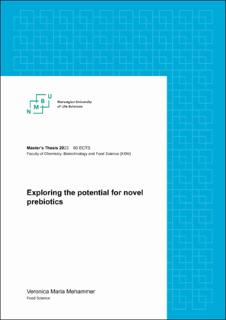| dc.contributor.advisor | Bjørge Westereng | |
| dc.contributor.advisor | Lars Jordhøy Lindstad | |
| dc.contributor.author | Mehammer, Veronica Maria | |
| dc.date.accessioned | 2023-10-26T16:27:09Z | |
| dc.date.available | 2023-10-26T16:27:09Z | |
| dc.date.issued | 2023 | |
| dc.identifier | no.nmbu:wiseflow:6839639:54592786 | |
| dc.identifier.uri | https://hdl.handle.net/11250/3099004 | |
| dc.description.abstract | Abstract
Despite emerging evidence showing the connection between health and gut microbiota, there is still much unknown. Previous research has examined the ability of the common gut bacteria Bacteroides spp. to degrade native spruce mannan and birch xylan to gain more knowledge about the potential of using wood hemicelluloses as a sustainable source of novel prebiotics. Selective stimulation is essential for an effective prebiotic as the aim is to create a competitive advantage for beneficial gut bacteria.
Further research is needed on these substrates before they can be considered as prebiotics. The development of a methodology for investigating interactions between gut bacteria and substrates is also needed. Fluorescence labeling of complex carbohydrates may be a possible way to quickly and easily screen for bacteriological interactions with potential novel substrates in both isolates and consortia of bacteria.
This study aimed to investigate the possibility of enzymatically removing the 2-O acetylations in spruce mannan used in fermentations to gain more knowledge about its potential as a prebiotic substrate. There have also been efforts to further develop a screening method for rapid investigation of bacterial interactions with substrates, based on fluorescently labeled substrates and epifluorescence microscopy. A preliminary experiment was also performed to obtain viable cells from a fecal sample of a piglet fed with a feed containing fluorescently labeled mannan.
The results showed no additional growth in response to the removal of acetylations by the bacteria used in this study. The results from epifluorescence microscopy showed that the growth (OD600) and fluorescence intensity did not seem to correlate. This has implications for the use of this technique to confirm internalization, as it is uncertain whether the substrate is internalized or whether it is associated with the bacterial surface. The experiment performed with a porcine fecal sample provided viable cells in the selected medium, and epifluorescence microscopy revealed the presence of fluorescent cells. | |
| dc.description.abstract | | |
| dc.language | eng | |
| dc.publisher | Norwegian University of Life Sciences | |
| dc.title | Exploring the potential for novel prebiotics | |
| dc.type | Master thesis | |
